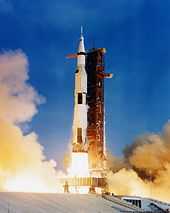Saturn V-3
The Saturn V-3, also known as the Saturn MLV 5-3, was a conceptual heavy-lift launch vehicle that would have utilized new engines and new stages that were never used on the original Saturn V. The Saturn V-3 was studied by the NASA Marshall Space Flight Center in 1965.
The first stage was to have used new F-1 engines designated F-1A which utilized a pump-fed design, an anticipated 20% additional thrust, and a six second improvement in specific impulse on an F-1, with the first stage stretched 20 feet.
The second and third stages were proposed to use new HG-3 engines in place of the J-2 engines, but were never used, although the HG-3 led to the development of the Space Shuttle Main Engine.
The V-3 booster was one of six Saturn MLV designs that never flew, but if these vehicles had been manufactured, they could possibly have been used for the Apollo Applications Program, Manned Orbiting Research Laboratory, Mars fly-by and Mars landing missions in the 1970s and 1980s, instead of the Space Shuttle Program which ran until 2011..
References
- Lowther, Scott, Saturn: Development, Details, Derivatives and Descendants
- Saturn V Improvement Study, Final report, NASA Contract NAS8-11359.
| ||||||||||||||||||||||||
